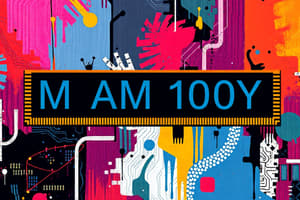Podcast
Questions and Answers
In a crossbar array of Resistive RAM (RRAM) cells, the wordline drivers are responsible for providing the write voltages to the rows of the array.
In a crossbar array of Resistive RAM (RRAM) cells, the wordline drivers are responsible for providing the write voltages to the rows of the array.
True (A)
The 1T1R RRAM cell configuration requires only a single transistor per memory cell, reducing area overhead compared to the 1R configuration.
The 1T1R RRAM cell configuration requires only a single transistor per memory cell, reducing area overhead compared to the 1R configuration.
False (B)
Sense amplifiers are used to read the stored data from the crossbar array by detecting the resistance state of the RRAM cells.
Sense amplifiers are used to read the stored data from the crossbar array by detecting the resistance state of the RRAM cells.
True (A)
The FeFET (Ferroelectric FET) technology provides higher accuracy but lower energy efficiency compared to CMOS for in-memory computing applications.
The FeFET (Ferroelectric FET) technology provides higher accuracy but lower energy efficiency compared to CMOS for in-memory computing applications.
The $L_\infty + L_1$ distance hardware configuration using separate TCAM and CiM components requires twice the memory compared to using a single CMA component.
The $L_\infty + L_1$ distance hardware configuration using separate TCAM and CiM components requires twice the memory compared to using a single CMA component.
In-DRAM bulk bitwise operations such as COPY, ZERO, AND, OR, NOT, and MAJ can be supported at a low cost using the FeFET technology.
In-DRAM bulk bitwise operations such as COPY, ZERO, AND, OR, NOT, and MAJ can be supported at a low cost using the FeFET technology.
The 1R*2 RRAM cell configuration requires two resistive memory elements per cell, increasing the area overhead compared to the 1R configuration.
The 1R*2 RRAM cell configuration requires two resistive memory elements per cell, increasing the area overhead compared to the 1R configuration.
The bitline drivers in a crossbar array are responsible for providing the read voltages to the columns of the array during data retrieval.
The bitline drivers in a crossbar array are responsible for providing the read voltages to the columns of the array during data retrieval.
The $L_2$ distance hardware configuration uses a GPU for in-memory computing, providing high accuracy but also high energy consumption and latency.
The $L_2$ distance hardware configuration uses a GPU for in-memory computing, providing high accuracy but also high energy consumption and latency.
The FeFET technology provides better energy-delay product (EDP) improvement compared to CMOS for the attentional layer in in-memory computing applications.
The FeFET technology provides better energy-delay product (EDP) improvement compared to CMOS for the attentional layer in in-memory computing applications.




